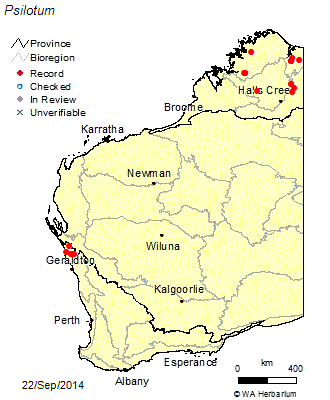The genus Psilotum comes from the family Psilotaceae and has only two species, Psilotum nudum (image 1) and Psilotum complanatum (image 2).

Image 1. Psilotum nudum

Image 2. Psilotum complanatum.
Psilotum nudum is not threatened and is native to Western Australia.
This genus can grow either on the ground of on another plant. They produce only one type of spore and their underground stem system, which is divided into two parts, lacks roots and does not contain the pigments necessary to convert light into energy. They have an aerial shoot system that can be erect or overhanging and can also be divided multiple times. It has small leaves which do not produce spores. The leaves are scale-like and lack a vascular nerve, they split into two and are spore producing. There are many large spores that are yellow in colour and double sided. The gametophytes are found underground with fleshy roots that are similar to rhizomes. The plant’s eggs and sperm can be in zones or consistently spread out.
Psilotum hold onto some primitive features of the first ever land plants. (ref botany for degree book)
Thrives in tropical and subtropical environments and therefore can be found in Florida, Mexico, several Pacific Islands, Hawaii islands, India and more. Psilotum is also found in several places within Australia (image 3), most abundant on the east coast of Australia. There are also several areas in Western Australia that Psilotum is present in (image 4). Psilotum nudum is native to Western Australia. It is also found in New South Wales, Queensland and Victoria. Psilotum complanatum is not found in Western Australia but is in South Australia.

Image 3. Map of Psilotum distribution across Australia.

Image 4. Map of Psilotum distribution across Western Australia.
Shrub land, aerial habitat and subterrestrial habitat.

Recent comments